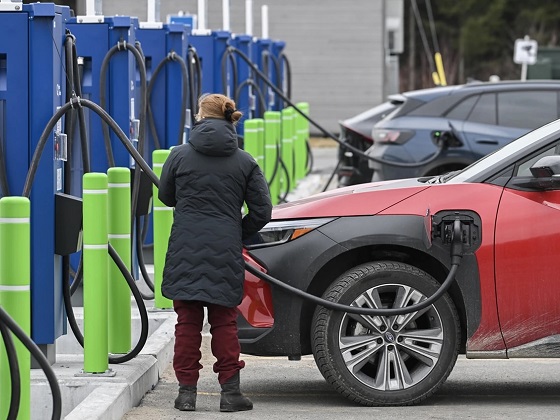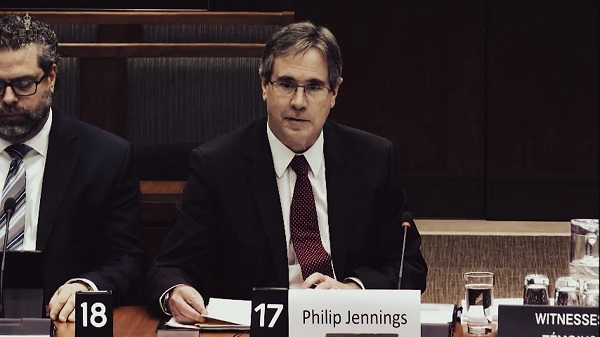National
Trudeau must prove he won’t tax our homes

From the Canadian Taxpayers Federation
Author: Franco Terrazzano
Actions speak louder the words. That’s especially true when those words come from a politician with a track record of breaking promises and hiking taxes.
Prime Minister Justin Trudeau says he won’t send the taxman after Canadians’ homes. But if Trudeau wants Canadians to believe he won’t impose a home equity tax, there’s one thing he must do: end the CRA’s home reporting requirement.
In 2016, the Trudeau government made it mandatory for Canadians to report the sale of their primary residence even though it’s tax-exempt. If you sell your home, the CRA wants to know how much money you received from that sale. But if the taxman isn’t taxing it, why is the taxman asking that question? Is the CRA just curious?
Official Opposition Leader Pierre Poilievre confirmed to the Canadian Taxpayers Federation he would remove this reporting requirement if he forms government.
Trudeau must do the same. Otherwise, Canadians should worry a home equity tax is right around the corner. As Toronto Sun Columnist Brian Lilley recently wrote, “For Justin Trudeau and his Liberal Party, taxing your primary residence is a bad idea they just can’t quit.”
On June 25, Trudeau attended “a private town hall about generational fairness,” hosted by Generation Squeeze, a group advocating for home taxes.
What do you notice about the theme of that town hall? The government recently used the cloak of generational fairness to impose its capital gains tax hike.
The Trudeau government also spent hundreds of thousands funding and promoting a report from Generation Squeeze that complained of the “housing wealth windfalls gained by many home owners while they sleep and watch TV.”
The report recommended charging a tax on the value of homes above $1 million. The tax would cost Canadians up to $5.8 billion every year, and it would hit many normal Canadians. In British Columbia and Toronto, the typical home price is above $1 million.
Trying to improve affordability with tax hikes is like trying to boil water with your freezer. Higher taxes won’t make homes affordable. Consider this insight 50 pages into the report.
“Owners of homes valued over $1 million that include informal rental suites may try to recover the surtax by passing some of its cost on to renters,” reads the report.
It turns out higher taxes can make things cost more.
The head of Generation Squeeze was invited to a cabinet ministers’ retreat in Charlottetown last summer.
Documents uncovered by the CTF show staff in the prime minister’s office met twice with the head of Generation Squeeze, which included “a briefing about the tax policy recommendation.”
Trudeau has an appetite for taxing people’s homes. His recent capital gains tax hike will impact Canadians who sell secondary residences and cottages. He imposed a so-called anti-flipping home tax. And Trudeau taxes homes the government deems “underused.”
With Trudeau scrounging through the couch cushions looking for more money to paper over his deficits, Canadians should worry a home equity tax is next.
A home equity tax would come with a big bill for a young couple looking to upgrade to a family home or for grandparents who rely on the equity in their home to fund their golden years.
As an example, Canadians that bought their Toronto home for $250,000 in 1980 and sold it for $1.2 million today would pay between $50,000 and $190,000, depending on the type of home equity tax.
The Trudeau government has repeatedly flirted with home equity taxes. The only way for Trudeau to put Canadians’ minds at ease is to act and remove the requirement for taxpayers to report the sale of their home to the CRA.
Business
Carney’s Toronto cabinet meetings cost $530,000

By Jen Hodgson
Prime Minister Mark Carney’s two-day cabinet meeting in Toronto cost taxpayers more than $532,000, records reviewed by the Canadian Taxpayers Federation show. Carney’s cabinet meetings cost thousands of dollars more than recent cabinet retreats hosted by former prime minister Justin Trudeau.
“If you’re spending thousands of dollars more than Trudeau on meetings, you’re spending too much money,” said Franco Terrazzano, CTF Federal Director. “It’s going to be hard for politicians to explain to taxpayers why all of the meeting rooms in Ottawa weren’t good enough.”
Carney’s two-day cabinet meeting was held at the Pan Pacific Toronto in September, according to government records submitted in response to an Order Paper Question. Pan Pacific’s website describes itself as a “luxury hotel.”
The Privy Council Office spent $250,400 on the venue and “hospitality,” $78,700 for audiovisual services, $40,000 for security and $8,073 on shipping. The PCO spent another $38,300 on accommodation, meals and transportation.
The total bill to taxpayers may balloon higher. The PCO noted costs only include expenditures processed as of Sept. 23. “Certain associated travel claims and invoices may still be awaiting submission or receipt,” wrote the PCO.
The Royal Canadian Mounted Police spent $29,000 on the cabinet meeting. That only includes expenditures processed as of Sept. 17.
The Translation Bureau charged taxpayers $30,600 for travel expenses, travel time and interpretation services.
Other departments also spent $57,400 for the cabinet meeting. Most of that was for transportation, but some ministers charged taxpayers for meals and accommodation for themselves and their staff.
Carney’s Toronto cabinet meeting cost more than recent cabinet meetings hosted by Trudeau.
Trudeau’s cabinet retreat to Charlottetown, P.E.I., in August 2023, cost taxpayers $485,196. Even after adjusting for inflation, Trudeau’s cabinet retreat cost about $26,000 less than Carney’s.
The Trudeau government also held a cabinet meeting in Vancouver in 2022. It cost taxpayers $471,070. Even after adjusting for inflation, Trudeau’s cabinet retreat cost about $25,000 less than Carney’s.
“Carney told Canadians he was going to cut waste and he should start by not dropping half a million bucks on meetings,” Terrazzano said. “We need a culture change in Ottawa and that needs to start with the prime minister and ministers respecting taxpayers’ hard-earned money.”
MAiD
101-year-old woman chooses assisted suicide — press treats her death as a social good

From LifeSiteNews
It must be said: The media’s relentless glamorization of suicide is repulsive and shameful.
It was once standard press practice to treat suicide as a tragedy. But since assisted suicide and euthanasia are now presented as the final front in the war for total autonomy, “human interest” stories now push the interests of the death lobby and treat suicide as a social good. The message this sends to the suicidal and desperate is clear.
The latest example of this is a December 2 story in Le Journal de Quebec on the assisted suicide of 101-year-old Paulette Fiset-Germain. She died by lethal injection in her room at the Manoir Cap-Santé on December 1. The opening line of the story almost glows with approval:
A centenarian who had lost none of her intellectual capacity is now shining in the sky after choosing medical assistance in dying on Monday.
Fiset-Germain had been living independently and alone only a few weeks ago but suffered two falls and a stroke. Last week, she told the staff and fellow residents that she wanted to die by euthanasia — or what in Canada is called “MAID.”
“I started to have trouble using the walker, I have one hand that I can’t use, the other one that I have trouble with, I can’t see one side anymore,” she said. “I’m at the end. You know when the glass starts to spill, it’s time to do something. In addition, you have trouble 24 hours a day, you don’t sleep. We’re going to close the loop.”
The Journal emphasized that she said this in a “very serene” tone of voice — and made it clear that Fiset-Germain’s family were supportive. “My children accepted my decision because they know me, they know that I am ready for it,” she said. “It started when I broke my hip and couldn’t do anything anymore. My decision doesn’t cause me any stress. I can’t wait. When the doctor agreed, I said, ‘You’re giving me a really nice gift.’”
To be clear: That “gift” is a lethal injection. She chose suicide by doctor — and the media celebrated it. That is nothing short of glamorizing suicide. In fact, the Journal made clear that Fiset-Germain was “grateful for the opportunity (of) medical assistance in dying,” but that she hopes it is expanded. In fact: “The last moments of Mme Fiset-Germain will also be the subject of a documentary.”
So, in addition to the puff pieces about her suicide, we’re going to get death porn propaganda that will be used to push for more suicides, likely (I suspect, although no details are yet available) produced in partnership with the vultures at Dying with Dignity.
“It’s too tight,” the elderly woman explained of Canada’s euthanasia regime, which is so notoriously loose it has been condemned by the United Nations. “We have to expand to relieve many people. There are others who are embarrassed, who are afraid of their children’s reaction. Mine told me, ‘It’s my choice, it’s my body, it’s my life.’” Funny — it seems like whenever someone uses that phrase, somebody is about to get killed.
The Quebec press is not known for its glowing coverage of religious beliefs, but for the suicidal Fiset-Germain, they made an exception. “Since I was little, I believe that when you die you become a star. When you see a shooting star, it’s someone who has left and is looking for a place,” she explained. “I received very good care here and I am very happy to end my days here and die in my bed.”
The article made sure to mention that she will “donate her body to science,” and quoted one of her reminisces of working as a nurse during the war, when she met a badly wounded soldier: “He was 20 years old and had lost both eyes, both arms and both legs. He asked me if he could hear his mother’s voice. I arranged for him to go to his house to hear it. I don’t know what happened to him next, but at that time, you couldn’t ask for medical assistance in dying.”
Her best friend offered her almost-too-enthusiastic support. “It’s a good decision,” her cousin and best friend Louisette Huard said. “After the life she’s had, the physical state she’s in.” I must say that if my best friend thought my suicide was a “good decision,” it would certainly heighten my suicidal ideation, but perhaps that’s just me.
Only the head of Manoir Cap-Santé and another friend were willing to express their grief. “It hurts us, but we respect her decision,” Guylaine Dufresne said. Her friend, Adelyre Goeguen, was blunter: “I didn’t like it right away. It was still a shock, and I don’t accept it at all.”
That, in case you’re wondering, is the correct response to the suicide of a close friend.
-

 Daily Caller2 days ago
Daily Caller2 days agoTech Mogul Gives $6 Billion To 25 Million Kids To Boost Trump Investment Accounts
-

 Alberta2 days ago
Alberta2 days agoAlberta will defend law-abiding gun owners who defend themselves
-

 Business2 days ago
Business2 days agoCanada’s future prosperity runs through the northwest coast
-

 Alberta1 day ago
Alberta1 day agoThis new Canada–Alberta pipeline agreement will cost you more than you think
-

 National2 days ago
National2 days agoCanada Needs an Alternative to Carney’s One Man Show
-

 MAiD1 day ago
MAiD1 day agoFrom Exception to Routine. Why Canada’s State-Assisted Suicide Regime Demands a Human-Rights Review
-

 Business1 day ago
Business1 day agoNew Chevy ad celebrates marriage, raising children
-

 Automotive1 day ago
Automotive1 day agoPower Struggle: Governments start quietly backing away from EV mandates








